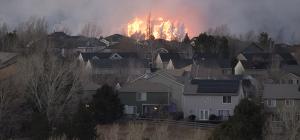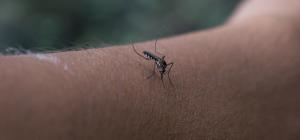
The health impacts of drought in Canada

Drought is defined as an extended period of abnormally dry weather that depletes water resources for human and environmental needs. It is important to note that for drought to occur, the number of days with precipitation does not need to have decreased. Rather, overall precipitation amounts are lessened to a degree that leads to depletion of water resources. In Canada, droughts have predominantly affected the southern Prairies and the interior valleys of British Columbia, which lie in the lee of major mountain ranges and as a result, receive less precipitation. While droughts have also occurred further east, these events are usually shorter, less frequent and less intense, though there have been exceptions.
Like extreme heat, climate change is altering the frequency, severity, and duration of droughts around the world, with hotter temperatures increasing both the evaporation and surface drying of water resources. Future projections indicate that while annual precipitation amounts will increase over most of southern Canada, this will be countered by decreased summer precipitation alongside increased temperatures. Together, these factors will contribute to greater evaporation and a higher risk of drought, especially in the southern Prairies and interior BC. These projections also revealed that multi-year droughts lasting 10 years or more will be more than 3 times as likely in Canada than what has been experienced historically.
While climate anomalies are the root cause of most droughts, human impacts on water resources and the increasing demands for water are both major contributing factors, and have led some to propose anthropogenic drought as a new term.
The direct effects of drought often include decreased lake and reservoir levels, reduced stream flows, depleted groundwater availability, and diminished soil moisture. These effects can lead to extensive environmental impacts, such as increased risk of wildfires, loss of wetlands, reduced water quality, erosion and degradation of soil, and destruction of ecological habitats. In addition, they can also lead to downstream socioeconomic impacts such as decreased income levels, altered environmental services like hydroelectric power generation, and altered hygiene practices. The table below explores negative health outcomes that may arise as a result of drought.
|
Health impact from drought |
|
|
Respiratory disease |
Dry conditions coupled with soil erosion can lead to an increase in fine particulate matter and dust concentrations in the air, causing respiratory illnesses. |
|
Pesticide exposure |
Pesticides, herbicides and fertilizers applied during hot and dry conditions are more likely to drift onto non-target areas. If over-applied, they can accumulate and lead to greater environmental toxicity. |
|
Food-borne disease |
Hot and dry conditions can result in the proliferation of certain food-borne pathogens, such as norovirus and Cryptosporidium. |
|
Vector-borne disease |
Reduced water levels may lead to improved mosquito breeding conditions by concentrating available water and creating organically rich water bodies that congregate hosts and vectors, thereby increasing the frequency of transmission events. |
|
Water-borne disease |
Reduced water levels and stream flow can result in stagnation of water sources during drought, increasing contaminant concentrations in ground and surface waters. |
|
Mental health illness |
Reduced crop production from droughts can lead to loss of income and increased stress levels. |
While these health impacts could affect people to different degrees, some populations are at greater risk given either their susceptibility to disease or their reliance on industry directly impacted by drought. These include pregnant people, young children, older adults, agricultural workers, and rural populations.
EPH professionals can play an important role in their communities to protect against health impacts caused by drought. This includes sharing information with the public on how to prepare for a drought, as well as continuing to monitor for water, vector and food-borne diseases.
The resources presented below provide information for monitoring and forecasting drought across Canada, as well as the connection between drought and human health. Finally, adaptation strategies for drought are also highlighted.
Monitoring and forecasting drought
- Canadian drought monitor (Government of Canada, 2023)
This website shares a monthly map of drought designations across Canada indicating both extent and intensity. Additional resources linked on this website include a drought analysis tool and historic drought maps and data.
- Canadian drought outlook (Government of Canada, 2023)
This website provides a monthly drought forecast, with maps displaying predictions of whether drought conditions across Canada will develop, stay the same, or improve by the end of the following month.
- Drought and water scarcity (ClimateReadyBC, 2023)
This website provides a range of drought resources from hazard maps and tools to a handbook for water suppliers, the BC drought and water scarcity response plan, plus additional resources and case studies.
- Drought and human health in Canada (Climate data, 2023)
This website provides an overview of how drought severity (modeled using the Standardised Precipitation Evapotranspiration Index (SPEI)) may change in the future across Canada in response to low, moderate and high greenhouse gas emissions. This tool allows projections for different Canadian cities to be viewed.
- Drought.gov (National Integrated Drought Information System, 2023)
This website provides a range of information on drought science and preparedness in the US, including drought monitoring, early warning systems, resources for public health, and emerging research.
- Handbook of drought indicators and indices (Integrated Drought Management Program, 2016)
This handbook outlines the importance of monitoring droughts and covers some of the most commonly used drought indicators and indices being applied across drought-prone regions.
The health impacts of drought
- Public health implications of drought in a climate change context: A critical review (Salvador et al., 2023)
This article provides an overview of trends in drought occurrence and the main impacts of drought on health. Adaptation policies and recommendations to enhance resilience to drought are discussed.
- Drought and public health in a changing climate (BC Centre for Disease Control, 2023)
This webinar by Dr. Jesse E. Bell provides an overview of the public health impacts of drought, describes the major pathways of these health impacts and the role of climate change in these processes.
- The association between drought exposure and respiratory-related mortality in the United States from 2000 to 2018 (Gwon et al., 2023)
This article assesses the effects of monthly drought exposure on respiratory mortality in the US, finding differences based on demographics and climate regions, with the elderly and people in non-metro counties having a higher risk.
- Natural hazards (Health Canada, 2022)
Section 3.7 of this Chapter In: Health of Canadians in a changing climate highlights the impacts of climate change on drought, with sub-sections on the effects of drought on human health and populations most at risk.
- Health implications of drought (Centers for Disease Control and Prevention, 2020)
This website provides a brief overview on the health implications of drought, covering air quality, food and nutrition, sanitation and hygiene, and recreational risks, among others.
- A scoping review of drought impacts on health and society in North America (Sugg et al., 2020)
This review article summarizes the societal impacts of drought from the public health impacts (e.g., disease, food insecurity, mental health), to the wider societal effects of compromised water quality and quantity (e.g., agriculture, electricity generation).
- Climate change and mental health: Risks, impacts and priority actions (Hayes et al., 2018)
This article summarizes current and projected climate change risks, including drought, and the consequent mental health impacts in the face of drought.
- Extreme events as sources of health vulnerability: Drought as an example (Ebi & Bowen, 2016)
This article reviews a framework for evaluating the risks of extreme weather events and uses drought to illustrate how such events will not only have an impact during or immediately following the event, but also well into the future, increasing the susceptibility of individuals, communities and health systems to future events.
- Climate change, drought and human health in Canada (Yusa et al., 2015)
This comprehensive review summarizes the various impacts drought events can have on human health, and assesses the state of knowledge on both direct and indirect adaptation strategies to protect health.
Drought adaptation
- Drought and public health: A roadmap for advancing engagement and preparedness (Bell et al., 2023)
This report, produced in partnership with the NOAA and NIDIS, provides insights into the connection between drought and human health impacts, and provides recommended actions to increase preparedness to reduce these impacts.
- Drought (US Environmental Protection Agency, 2023)
This website provides basic information on preparing for a drought for individuals, commercial buildings and schools, and communities, with recommendations for improving water efficiency.
- Adapting to extreme events: Small drinking water system manager perspectives on the 2012-2016 California drought (Klasic et al., 2022)
This article summarizes the experiences of small water system managers during a multi-year drought and identifies the characteristics that hinder resilience, and conversely enhanced resilience to drought.
- Building resiliency to multi-year drought (Alberta Water Council, 2021)
This website provides a guide for small and rural communities, along with factsheets and other supporting materials to support municipalities and small communities to build resiliency to multi-year drought.
- Drought and infrastructure: A planning guide (Cybersecurity and Infrastructure Security Agency with the National Drought Resilience Partnership, 2021)
This guide provides an overview of the potential impacts of drought on the operation of critical infrastructure such as water and wastewater, energy, and public health, and outlines key planning, mitigation and adaptation strategies in response to droughts. While this guide is developed for a US audience, its key messages remains applicable to the Canadian context.
- Resilience strategies for drought (Center for Climate and Energy Solutions, 2018)
This factsheet highlights strategies for communities facing a projected increase in drought conditions to build resilience. Sections include water conservation and public education, city planning, codes and ordinances, and water pricing among others.
- Limitations of Water Resources Infrastructure for Reducing Community Vulnerabilities to Extremes and Uncertainty of Flood and Drought (McMartin et al., 2018)
This paper evaluates current agricultural infrastructure, behaviour, and land use management in Canada, Argentina, and Columbia. Assessments examine the capacity and flexibility of the infrastructure to maintain and protect agricultural activities, livelihoods, and communities in the event of a major drought or flood.
- Improving the mental health of rural New South Wales communities facing drought and other adversities (Hart et al., 2011)
This paper describes the positive outcomes of a mental health program implemented in New South Wales, Australia to raise awareness and help address drought-related mental health in rural and remote areas of the state.
- Canadian prairie rural communities: their vulnerabilities and adaptive capacities to drought (Wittrock et al., 2010)
This paper provides an overview of how communities in the Canadian Prairies have adapted following the 2001-2002 drought and assesses their vulnerabilities to future drought situations.
- Adaptation strategies for drought (Environmental Resilience Institute, n.d.)
This webpage outlines adaptation strategies for drought, from infrastructural options like increasing water storage capacity or diversifying water supply to reducing public water consumption through public education campaigns or rebates.








